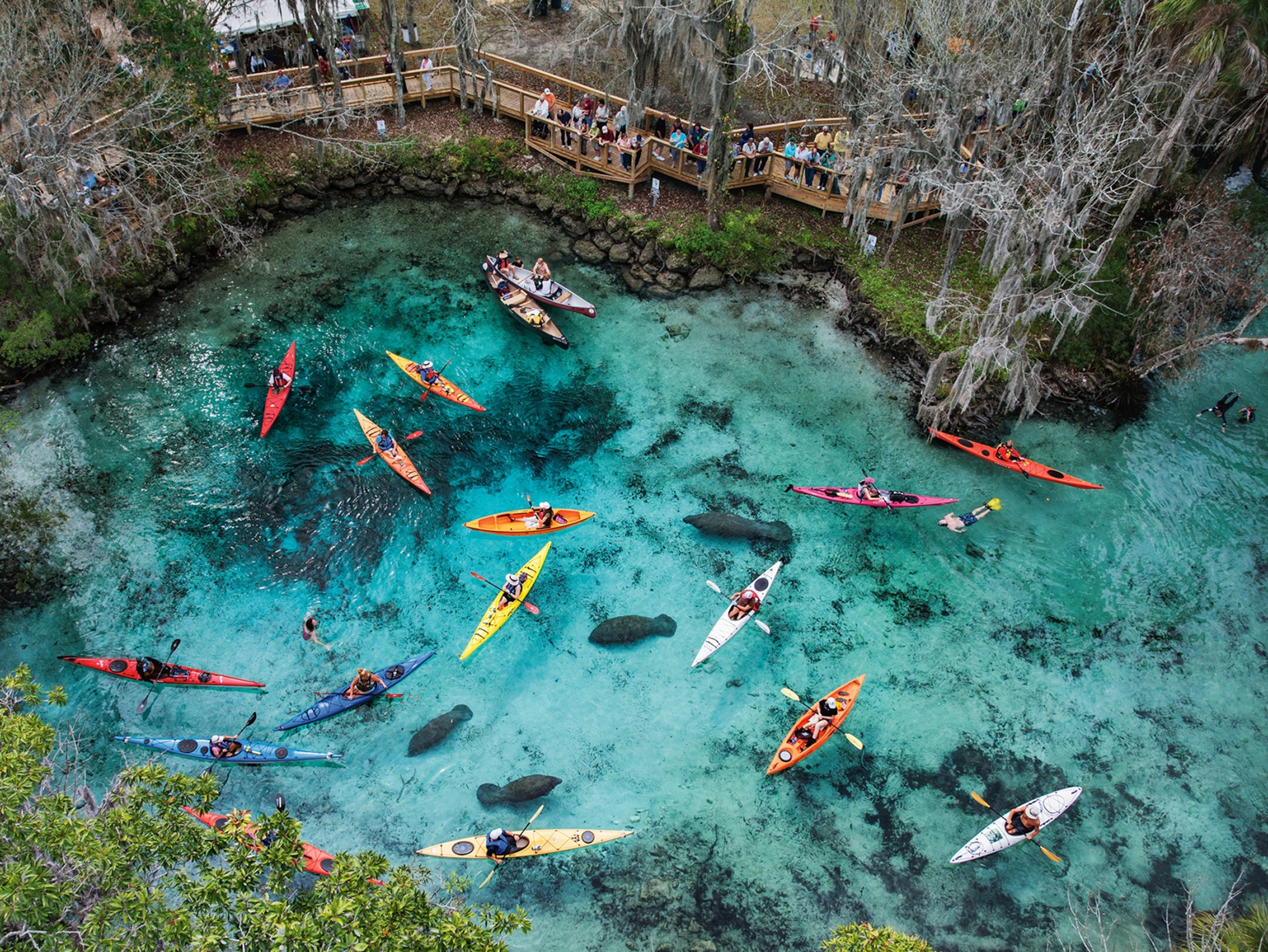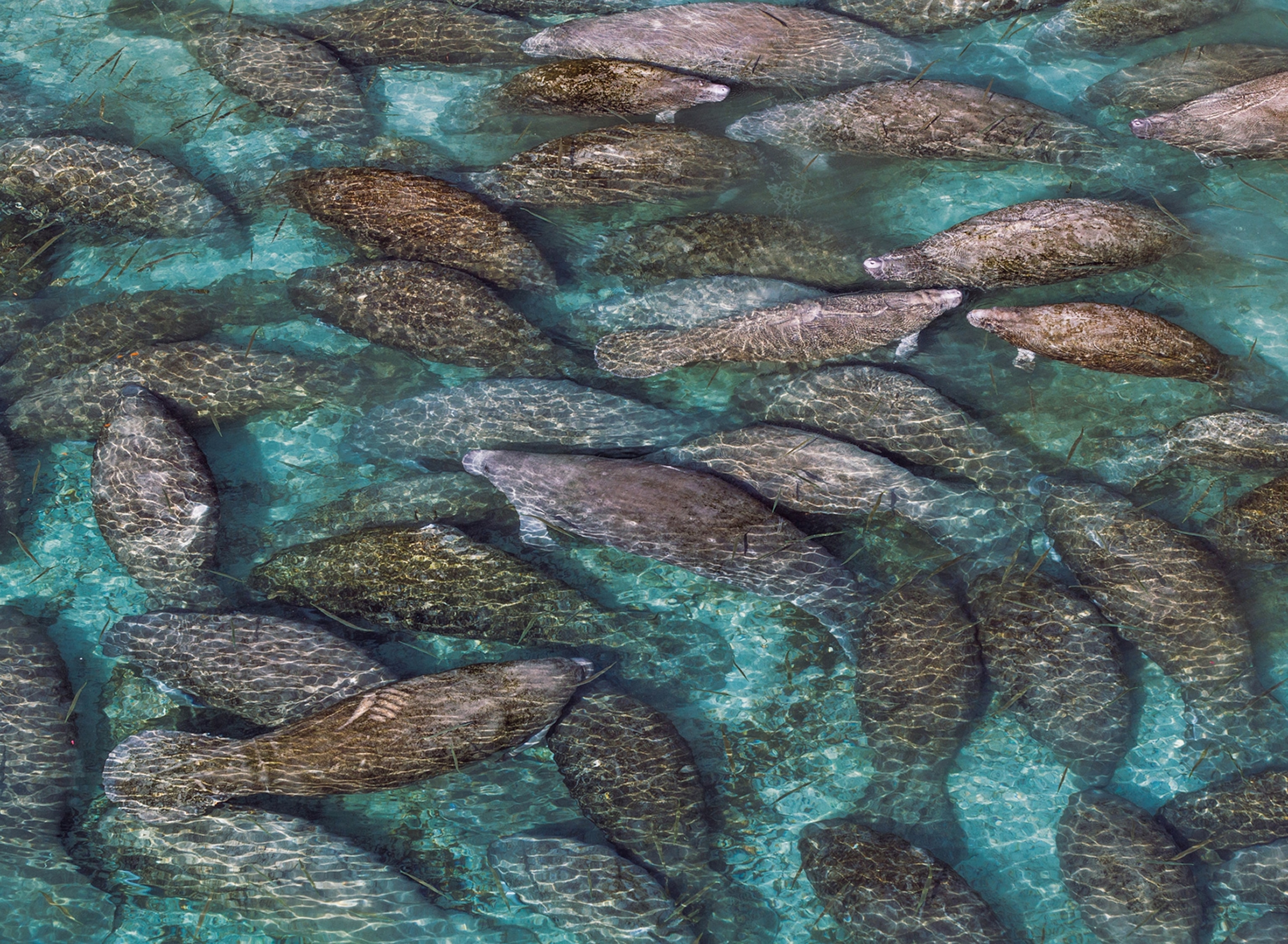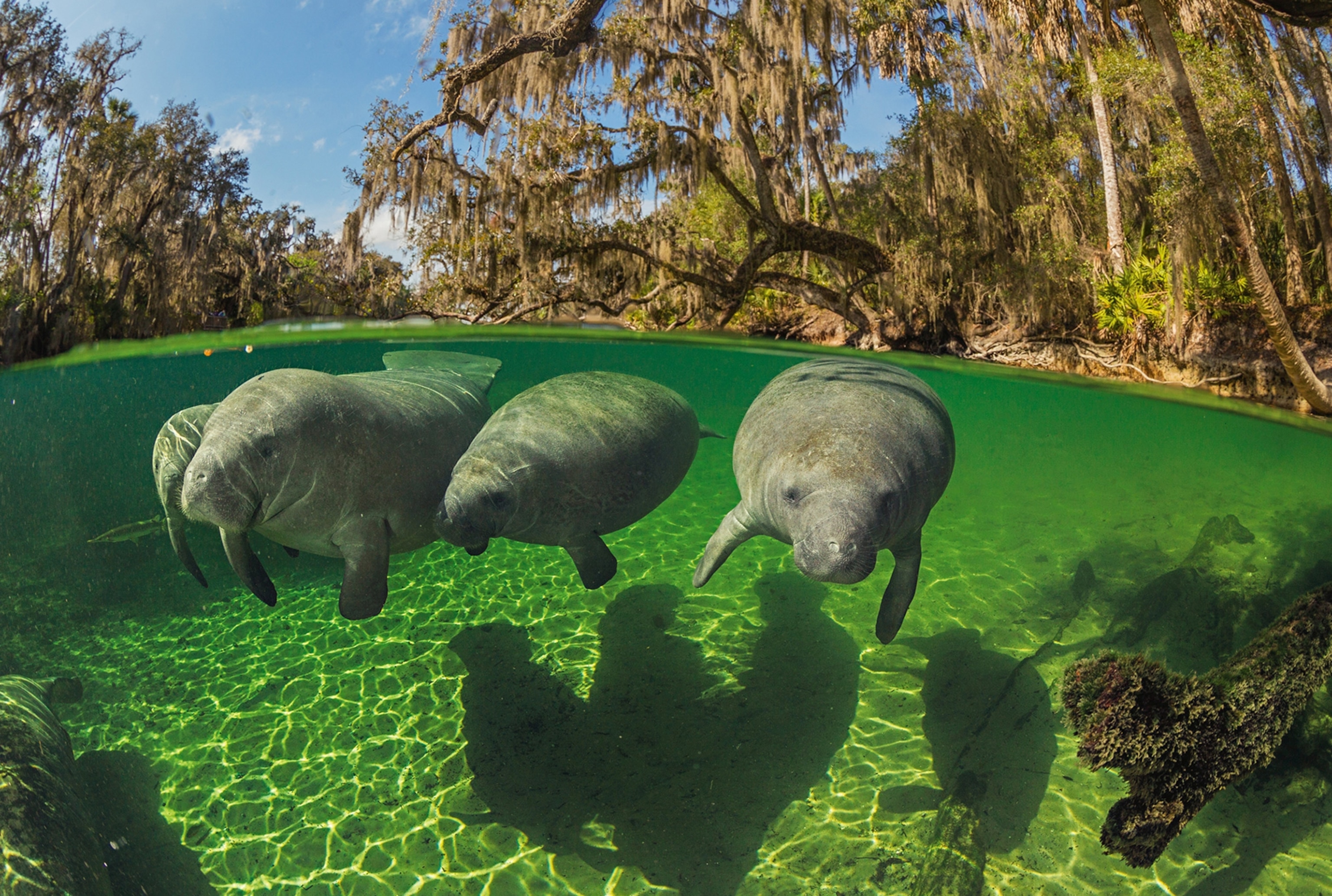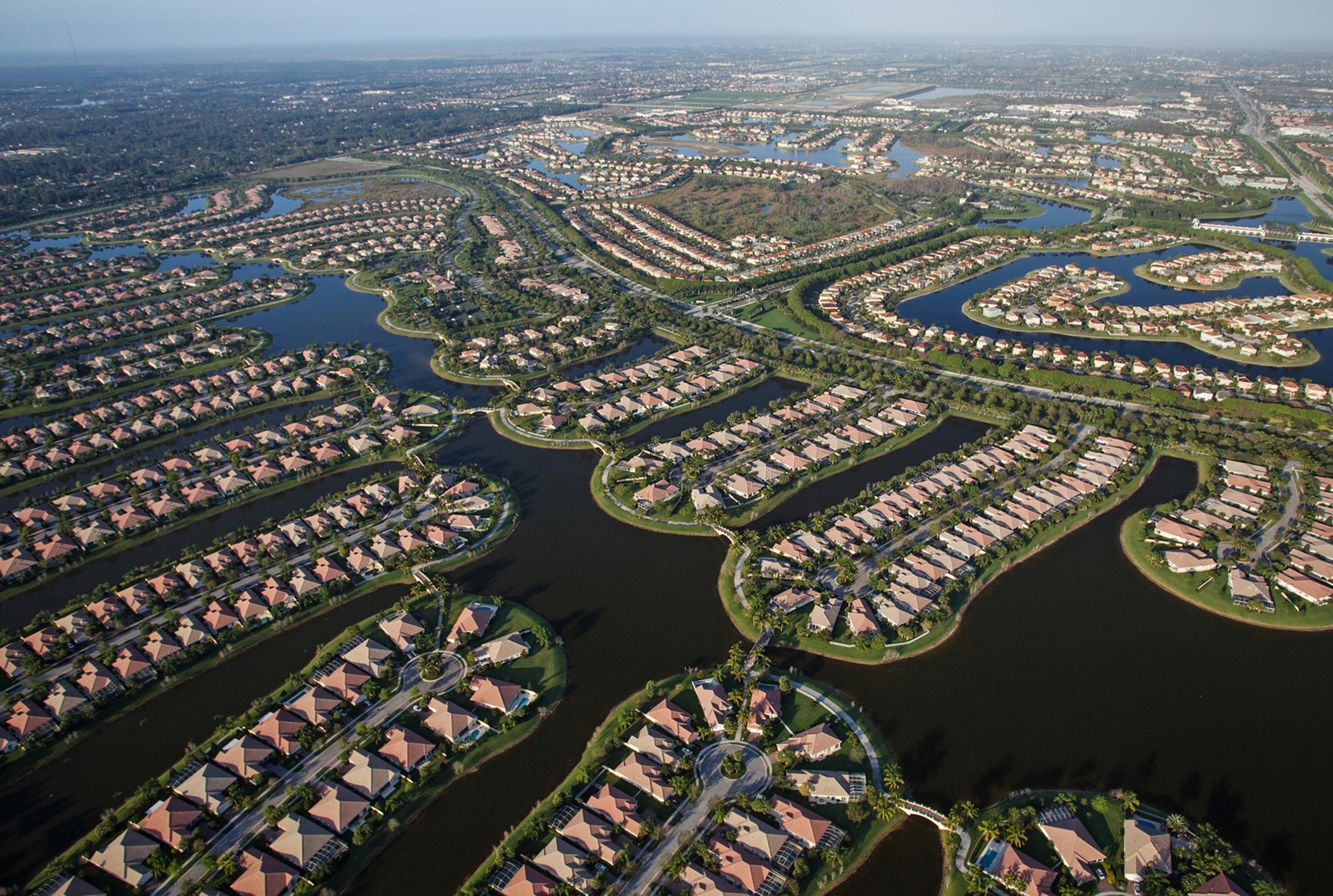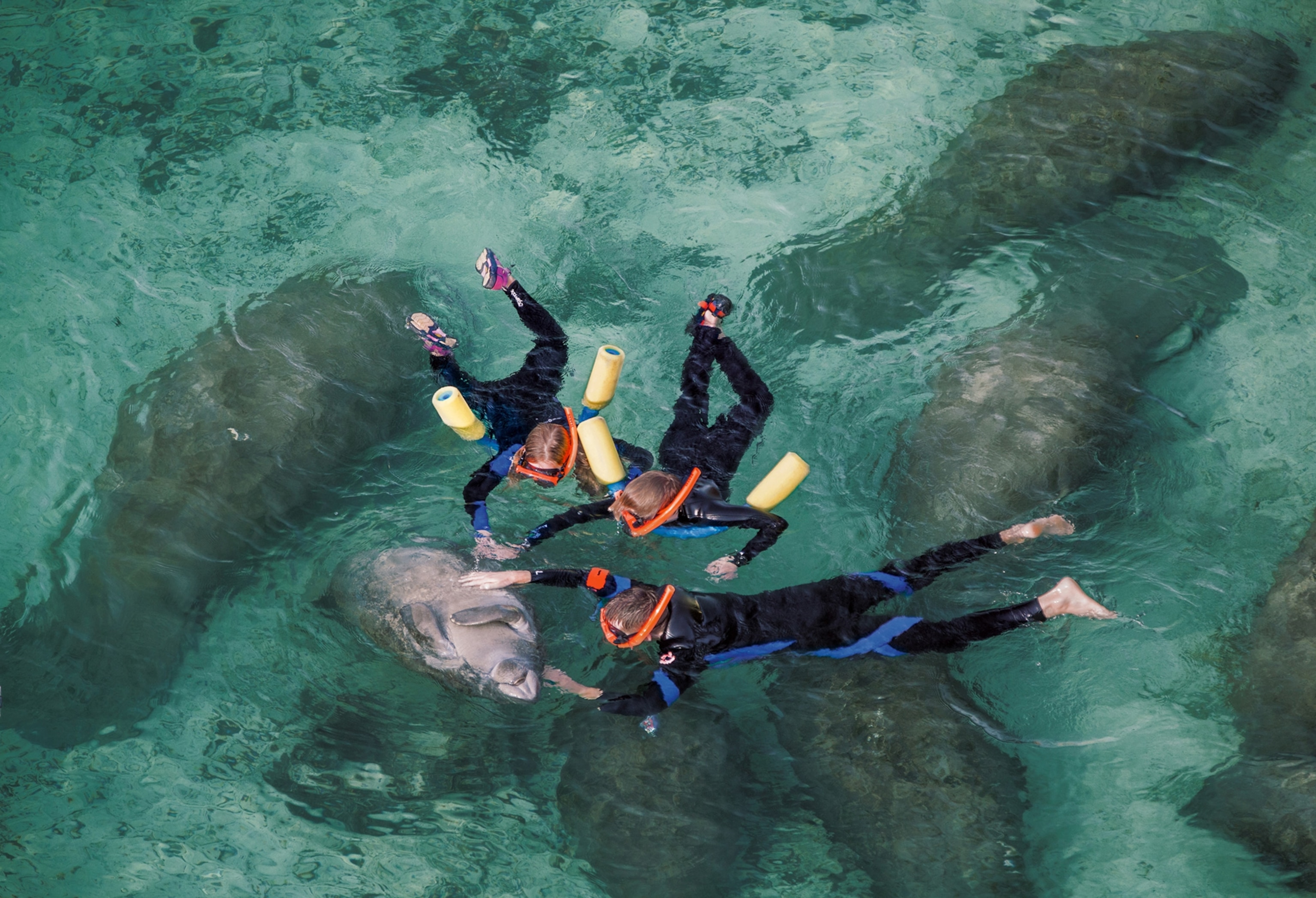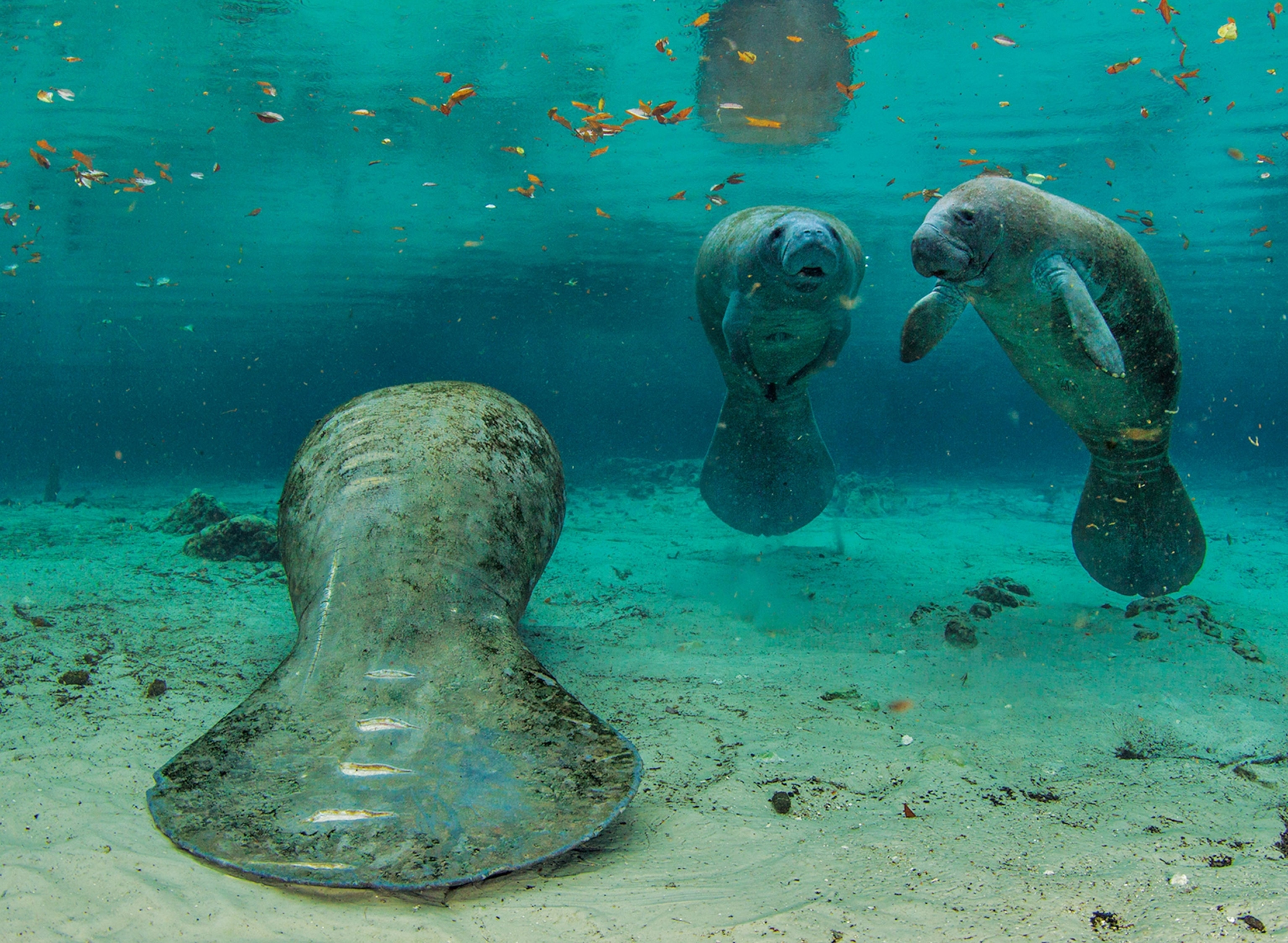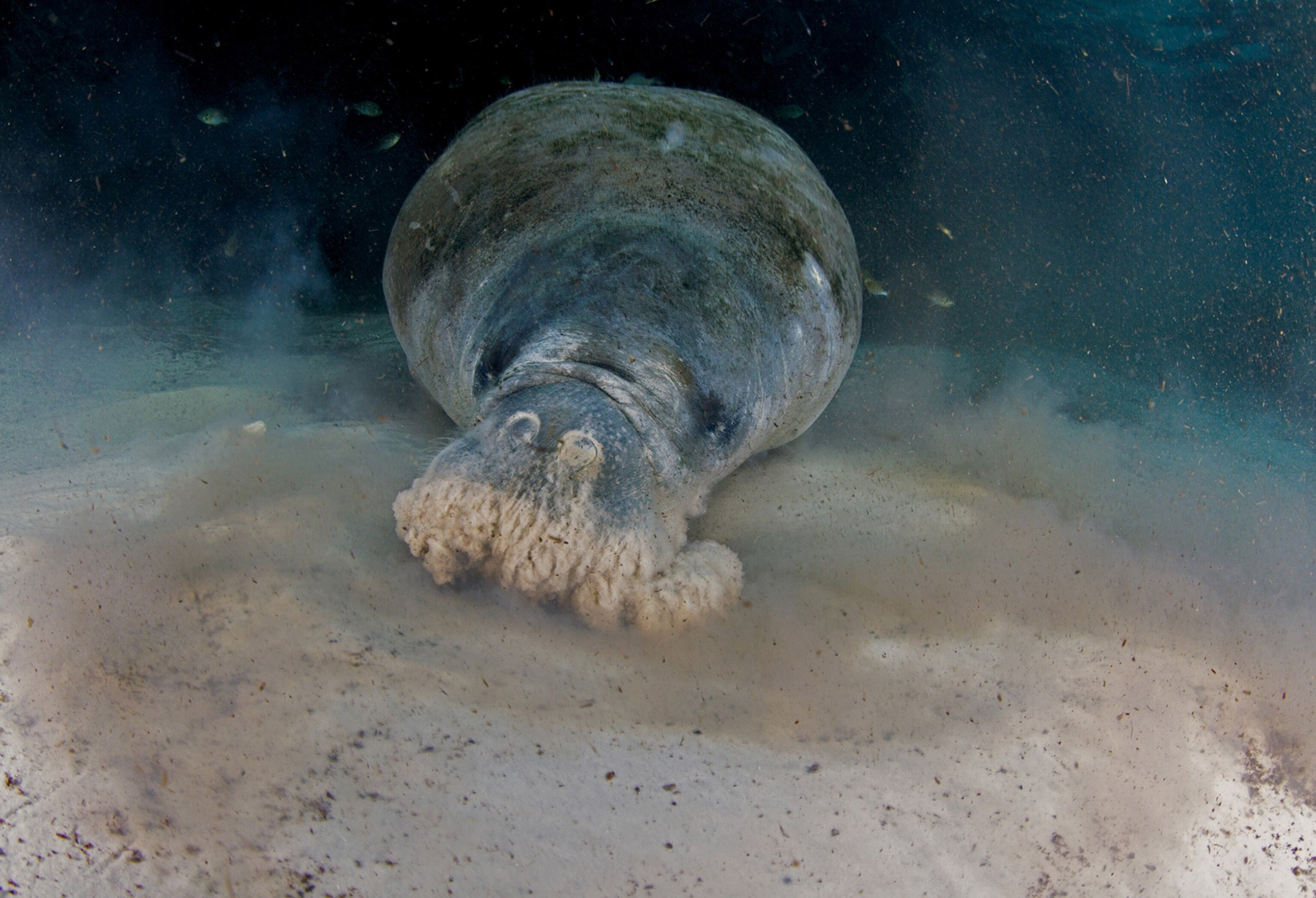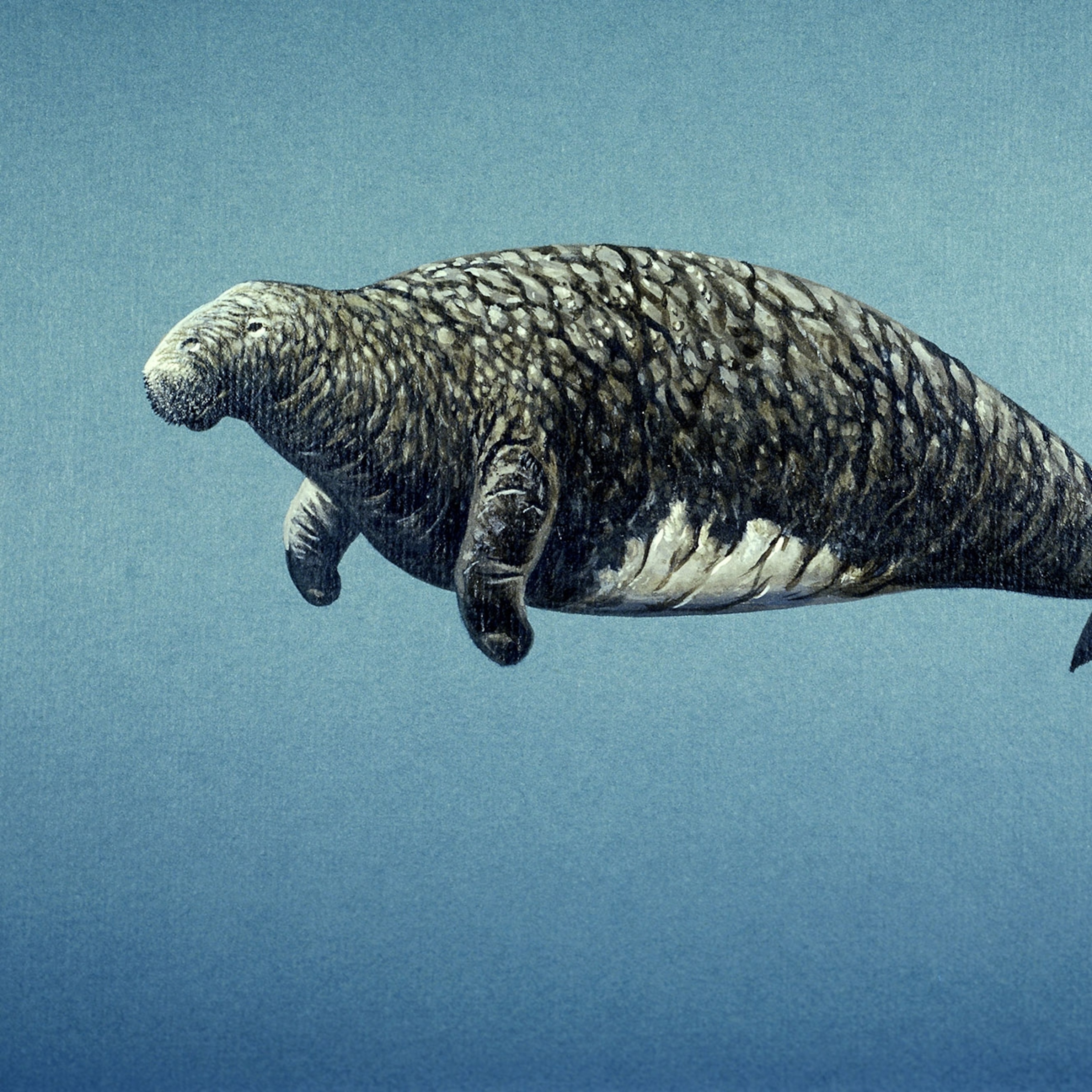When Push Comes to Shove
The Florida manatee is thriving in Kings Bay, and so is tourism. Therein lies the problem.
The welcome sign on the outskirts of Crystal River isn’t the kind you see every day: “Manatee Information: Tune to 1610 AM,” it reads. Then, too, not many towns have a red-white-and-blue statue of an endangered marine mammal in front of City Hall.
Stop to ask where you can see these aquatic celebrities, and you learn that a couple dozen local dive shops offer snorkeling tours in Kings Bay. Or you can rent a kayak and paddle to one of the warm springs where manatees hang out in winter. Or if you want to watch from dry land, you can head over to the canal west of Three Sisters Springs.
At the canal it takes only a few minutes before the first manatees cruise below, pale ghosts in the jade green canal. They pass alone, or with a single calf, or occasionally in groups of three or four. There’s a constant flow of people coming and going too.
“It’s like a big rusty oilcan floating in the water,” a man says.
“Why, they don’t look like nothin’ at all!” a woman exclaims in a Dixie drawl, and she has a point. The blobby shapes passing under the bridge will never win any wildlife beauty contests. The only color they show is the pink of propeller scars, parallel gashes like sidewinder rattlesnake tracks on their gray backs.
“There’s no room for the manatees,” says another man, noting the boat traffic sharing the narrow canal with the animals. “That’s how it goes.” He shakes his head ruefully. “Places get commercial, and people just don’t care.”
Oh no. No, sir. That’s where you’ve got it wrong. People have very strong opinions about manatees in Kings Bay. See the signs around town, the ones that say, “Save Crystal River” and “Get U.S. Fish and Wildlife Service Off Our Back”? Around here, people care about manatees more than you can imagine.
Crystal River National Wildlife Refuge administers a substantial part of Kings Bay, a 600-acre lake that discharges into the Gulf of Mexico 65 miles north of Tampa. The town of Crystal River adjoins the refuge—embraces it, you might say, geographically, though not always figuratively. Indeed, there have been times when some residents have treated refuge manager Michael Lusk as the uniformed embodiment of evil.
On his arrival at Crystal River in 2009, Lusk walked straight into a critical mass of contention: government regulation versus personal freedom, public access versus private property, change versus tradition, idealism versus money. And though the local conflicts mirrored national issues, their cause was unique, and uniquely ironic: the manatee, a creature as devoid of aggression as a teddy bear.
Weighing up to 1,200 pounds or more, the West Indian manatee looks something like a chubby dolphin or small whale, though it’s related to neither. (In fact, manatees share a common ancestor with elephants.) Manatees lack the blubber layer that allows whales to tolerate cold; in water below 68°F, they begin to weaken and die. The subspecies found in the United States is the Florida manatee, which disperses into coastal areas of the Atlantic Ocean and Gulf of Mexico; in winter, when sea temperatures drop, they congregate inland at natural springs and other sources of warmth, including power plant discharge pipes.
At Kings Bay manatees have a near-perfect winter refuge. Dozens of springs scattered around the bay pump out fresh water at a constant 72°F year-round. The Kings Bay area is so suited to manatees that the wintering population has grown from about 30 in the 1960s to more than 600 today, mirroring the species’ increase to about 5,000 throughout Florida. On any day from November through March, Crystal River residents can quite literally walk out their doors and see dozens of manatees swimming, loafing, and sleeping in city canals like lazy dogs curled up on the lawn.
“This is basically an urbanized wildlife species that lives in our backyard, 50 feet from where we sleep,” says USGS biologist Robert Bonde, who’s studied Florida manatees for more than 35 years. “They’re as wild as free-ranging elephants, yet here they are.”
This cozy proximity has made Crystal River the de facto manatee capital of the United States, a title enhanced by yet another unique circumstance. Nowhere else are people encouraged to enter the water and swim with manatees: approaching them, interacting, and even touching them. Such intimacy with an endangered and federally protected wild animal would never be permitted if it were proposed today, but the activity has long been a popular tourist draw at Crystal River, predating the Endangered Species Act of 1973 and the establishment of the refuge a decade later.
The “swim-with” program is just one of several issues that have conservationists, boaters, landowners, politicians, and tour operators facing off over the future of Kings Bay. And the U.S. Fish and Wildlife Service, which oversees the national wildlife refuge system and manages the manatee population, stands in the middle like the sheriff in a town of feuding clans, trying to keep the peace.
“There are plenty of wildlife issues, like wolves out west, that are just as controversial,” Michael Lusk says, “but the emotion around these animals is amazing.”
On a typical winter weekend Three Sisters Springs doesn’t look much like a wildlife refuge. Party barges, runabouts, kayaks, and swimmers crowd the narrow adjoining canal. Add some kegs of beer and blaring hip-hop, and it could be a fraternity party.
These folks are mostly as respectful and subdued as people can be when one-ton animals regularly swim past. The tour boat captains have lectured their customers: Don’t disturb resting manatees; don’t block them when they leave the roped-off area where people are forbidden. But kids squeal, and adults... Well, they sometimes do more than squeal.
Mike Birns leads tours to Three Sisters and other manatee-viewing spots around Kings Bay. “This happens on a regular basis on my trips,” he says. “Someone comes back to the boat, and she’s just bawling: ‘Oh it was great! It came right up to my face!’ She’s so overcome by emotion she can’t wait to go out and save the manatees. I’ll tell you, for a lot of people, it really is a spiritual experience.”
Manatee advocates agree that many of the more than 150,000 people who come to Crystal River each year to swim with (or kayak above) the manatees leave with a heightened appreciation for the animals—though that fact doesn’t excuse disruptive behavior. In 2006 local activist Tracy Colson began making videos of manatee abuse, including people riding manatees and guides taking babies from mothers to pass around to tourists. Her YouTube posts shocked manatee lovers and helped bring stricter guidelines for interaction.
Patrick Rose, an aquatic biologist and executive director of the influential Save the Manatee Club, somewhat grudgingly supports the swim-with program, though he’s determined to see changes made. “Most manatees don’t want to have much of anything to do with people,” he says. “They seek out quiet places to rest, especially on cold winter days and nights when their most critical priority is to stay warm.”
Rose believes the situation at Crystal River constitutes harassment of manatees, “in direct violation of both the Marine Mammal Protection Act and the Endangered Species Act.” He advocates stricter rules requiring swimmers to stop a body length away from manatees, which would then be free to interact or not, at their choosing. “The majority of the dive shops are trying to do a good job,” Rose says. “If they want to be responsible and protect the privilege they have here, which is so unique, then fine. If not, the swim-with program should go.”
Tracy Colson agrees. “There should be no rubbing or touching,” she says. “That’s what dogs are for. Manatees are wild animals. Let them be wild.”
The issue reaches deeply into pocketbooks. Estimates of the local economic impact of manatee-related tourism range from $20 million to $30 million a year. Some dive-shop owners claim they’d lose substantial business if customers weren’t able to go home and tell friends, “I touched a manatee.” Aware that their livelihood could be in jeopardy, 16 tour operators in 2011 formed the Manatee EcoTourism Association (META), working with the national wildlife refuge and the Save the Manatee Club to find a balance between access and protection. With Mike Birns as president, META has voluntarily adopted rules on human-manatee interaction that are sometimes even stricter than required by federal law.
For all the contention around swimming with manatees, it’s not the issue that’s caused the greatest controversy in Crystal River. The acrimony, accusations, and insults that have split the community, inspired full-page attack ads in newspapers, and poisoned the atmosphere at public meetings stem in large part from where, and how fast, people are allowed to drive their boats.
As air-breathing mammals, manatees spend much of their time near the surface, where they’re vulnerable to moving boats. With more manatees living in Kings Bay year-round, the U.S. Fish and Wildlife Service in 2012 tightened restrictions on the designated high-speed sports zone, cutting its size and lowering the speed limit from 35 miles an hour to 25 in summer. For residents already resentful of limits on the way they can use the bay in their backyards, the regulations represented an unacceptable infringement of their freedom by a too-powerful federal bureaucracy.
Some of those in the anti-regulatory Save Crystal River group believe the regulations are part of a wider plan by conservationists, who see the expanding Florida manatee population as a chance to establish more refuges and further restrict not just boating but economic development and private-property rights. “The big issue is making the entire bay a refuge,” resident Lisa Moore says. “If environmentalists win here, they’ve got it made. It’s all downhill from here.”
The notion that Crystal River residents are being punished for their successful stewardship of manatees has fueled residents’ anger; local T-shirts depict the U.S. Fish and Wildlife Service as a giant gorilla standing on City Hall.
“I don’t think any of us would disagree that manatees have done very well,” Michael Lusk says. “But that’s a testament to the fact that they have been protected. Saying they don’t need any more protection is like saying, Hey, our city is growing, so we don’t need any more traffic regulations, and we don’t need any more health codes.”
Pat Rose says Crystal River’s anti-refuge contingent—as well as boating interests and developers who continually work to weaken manatee protection laws throughout Florida—“have the money to fight for what they believe in, and more power to them. But I don’t think that should be confused with facts, or with the law.”
Yet another contentious issue looms in the not too distant future for Crystal River. Though tour boats take snorkelers and divers to several locations around Kings Bay, the narrow canal alongside Three Sisters Springs is by far the most popular. At times more than 200 manatees crowd into the area trying to rest and stay warm, while dozens of kayaks and scores of swimmers surround them and 20 or more tour boats lie anchored in the canal.
“What I hear from all the different user groups—the Save the Manatee Club, the city council, neighbors, kayakers, snorkelers—is that we need to manage the access into Three Sisters Springs when it’s full of manatees,” Lusk says. “Because it becomes an unpleasant experience not only for manatees but for people too.”
That’s easier said than done, though. Legal issues regarding waterway access and questions regarding the fair allocation of visitation rights complicate matters, and some dive shops and other local businesses would surely protest loudly at anything that might limit tourist numbers. As if a quota system weren’t controversial enough, Pat Rose of the Save the Manatee Club advocates making Three Sisters a true sanctuary for manatees, keeping snorkelers and kayakers out of the water entirely and allowing observation only from a boardwalk around the springs. If that proposal ever comes to the table, it might make the fight over Kings Bay speed limits seem tame.
In the meantime travel magazines and television shows continue to publicize the chance to swim with manatees at Kings Bay, and Crystal River’s appearance in the book 1,000 Places to See Before You Die sparks people’s imagination and desire for the once-in-a-lifetime experience of communing with these creatures.“There’s no other place like Kings Bay,” Michael Lusk says. “And it is precisely that uniqueness that will lead to escalating conflicts as more people flock here.
“I’d like to find that place where we can allow people to interact with manatees and have that powerful experience, but manage it so that manatees are protected and safe. And I think we can find that.”
Mike Birns has heard angry words at public meetings but has also seen opposing sides come together at times to compromise. “What’s funny,” he says, “is that the manatees have made us examine the very nature of how we govern ourselves.”
And so you too shimmy into a wet suit and put on a mask and slip into the canal at Three Sisters Springs. As you lower your head, water muffles the sound of people talking and laughing. You paddle near the roped-off sanctuary and stop, watching dozens of big gray shapes resting near the bottom, soaking in the springwater surging from the Earth, warming themselves before they venture back out into the bay to feed.
A manatee turns toward you, at once ponderous and graceful, and approaches, stopping when its face is just inches from your mask. What ensues, you tell yourself, is mutual contemplation.
Is a manatee ugly? Pretty is as pretty does, the saying goes, and a manatee does what it does very well. Its big, dense bones make it buoyancy neutral in the water; evolution didn’t consider that those bones would make it more likely to die from serious boat strikes. That flat, wrinkled face is as sensitive and muscular as a human tongue, perfectly adapted to allow a manatee to feed on aquatic grasses. Those strange hairs all over its face? They’re vibrissae, like the ones cats and dogs have, connected to sensors that relay the slightest tactile impulse to the brain. Cats and dogs have about 50 vibrissae on their faces; a manatee has 600.
It’s not the manatee’s fault that it evolved in an environment with abundant food and no predators, so that it became unwary and vulnerable, so that its survival depends on our regard for it, our willingness to share this crowded planet.
Contemplation time is over. The manatee swims past you, and you turn to watch it fade slowly from sight. Down here it’s the manatees’ world, and you’re just visiting.

